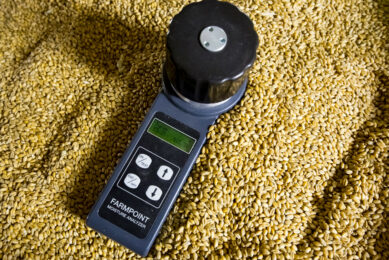Protecting the cells against mycotoxin damage
![The fungi Aspergillus niger, which produce aflatoxins. [Photo: Shutterstock]](https://www.allaboutfeed.net/app/uploads/2020/12/001_587_rb-image-2719385.jpeg)
Mycotoxin cytotoxicity leads to cell damage, hence leading to other problems in livestock animals. A mycotoxin binding product with different ingredients can help in keeping the cell viability high.
More than 300 different types of mycotoxins are known, which are different in origin, structure and toxic characteristics. The type of mycotoxin found at a certain place is influenced by the conditions in the area. Climatic factors, pH and the preference of some fungi for particular substrates are some of the variables in question. Table 1 shows the predominant type of toxin by geographic location. Animals are normally exposed not to only one mycotoxin, but rather to several toxins at the same time. When mycotoxins are present simultaneously, their interactive effects can be additive, antagonistic or synergistic in nature, in some cases causing more severe damage than when occurring in isolation.
Factors that produce mycotoxins
The main mycotoxin-producing fungi belong to Aspergillus, Penicillium and Fusarium genera. Their capacity to produce big quantities of mycotoxins is determined by different variables. Water activity (wa) is one of the most important factors; it is defined as the partial vapour pressure of water in a substance divided by the standard state partial vapour pressure of water. In other words, it expresses the amount of available water for microbiological development. High wa values are needed to support fungi activity. A value of 0.7 is sufficient, but values around 0.8-0.9 are needed to produce significant quantities of mycotoxins. Temperature is also a very important factor. The above-mentioned genera can grow in temperatures between -3 and 40º C, but their optimum temperature range is 25-30ºC. If we analyse pH, although their preferred condition is alkaline, their tolerance range is wide: 2.5 to 7.5.
Different detoxifying products
There is a growing interest in the market for detoxifying products based on the adsorption mechanism. This effect is a surface phenomenon consisting in the adhesion of a molecule to a solid surface. The nature of the bonding depends on the characteristics of the species involved. In this case, electrostatic and hydrophobic interactions are responsible for the mycotoxins’ adsorption. The objective of these types of products is to block the mycotoxins in the intestine, thus limiting their availability and consequently their metabolic effects. So the toxins must form a stable union with the product and remain with it until they are excreted. Aluminosilicates are a group of clays showing this adsorption capacity. They are divided into two subgroups: Phyllosilicates (as Bentonite) and Tectosilicates (as Zeolite). Due to their physical structure, these minerals present an elevated peripheral area value and active surface with binding points, which is the reason why they are able to interact with a wide range of substances, especially polar compounds. This property also confers elasticity when mixed with water and expansion capacity. Between the different layers of this tridimensional structure, bound cations can be exchanged in water solution for other ions; this is what is called cation exchange capacity (CEC). So some charged molecules are susceptible to substituting these cations and being absorbed by the material. In addition to this sequestering capacity, aluminosilicates are able to reduce the intestinal transit rate, enhancing digestibility and acting as gastric and intestinal protectors to prevent diarrhoea. Diatomaceous earths are another of the products found to have a great capacity for binding mycotoxins. Diatomite consists of the fossilised remains of diatoms, a type of hard-shelled algae. Mainly composed of silicium dioxide (SiO2), as well as aluminium oxide (Al2O3) and ferric oxide (Fe2O3), it shows a very low density and an extremely porous surface in which very reactive radicals (silanol) can be found. They are able to interact with organic polar compounds. This property is responsible for their mycotoxin binding capacity.
Testing the effect on cell viability
Not all products are able to effectively bind all the mycotoxins. A trial was therefore conducted with a mycotoxin binding product* to study its effect on cell viability. A higher cell viability is preferred, as this means that cells are better protected against the cell damage caused by the mycotoxins. Mycotoxin cytotoxicity is related to ROS (reactive oxygen species) accumulation and damage to DNA. This ability to cause oxidative stress and ROS-mediated DNA damage leads to cell cycle arrest and apoptosis. Mycotoxins are also known as protein synthesis inhibitors and interfere with membrane phospholipid metabolism. The presence of products capable of adsorbing the mycotoxins might prevent the generation of ROS and RNS. Due to their monolayer-forming ability and their morphologic and biochemical characteristics, human Caco-2 cells are used as a model in toxicity assays, also valid for animal production. To conduct the study, Caco-2 cells were cultivated in wells with a complete medium. Afterwards, the treatments (mycotoxins and mycotoxins + mycotoxin binding product) were added and remained in the wells for 24 h. Cytotoxicity MTT was evaluated (methodology: Denizot and Lang, 1986). It was shown that the viability of the cells treated with a mycotoxin binding product was higher for every mycotoxin tested (Figure 1).
Conclusion
The addition of a mycotoxin binding product, as described in this article, protected the cells against the above-mentioned mycotoxin’s deleterious effect and thus may be used as mycotoxicosis prevention products in animal feeds.
*Toxinor
Author:
Alvaro Ortiz, Norel, Spain
Join 26,000+ subscribers
Subscribe to our newsletter to stay updated about all the need-to-know content in the feed sector, three times a week. Beheer
Beheer











 WP Admin
WP Admin  Bewerk bericht
Bewerk bericht